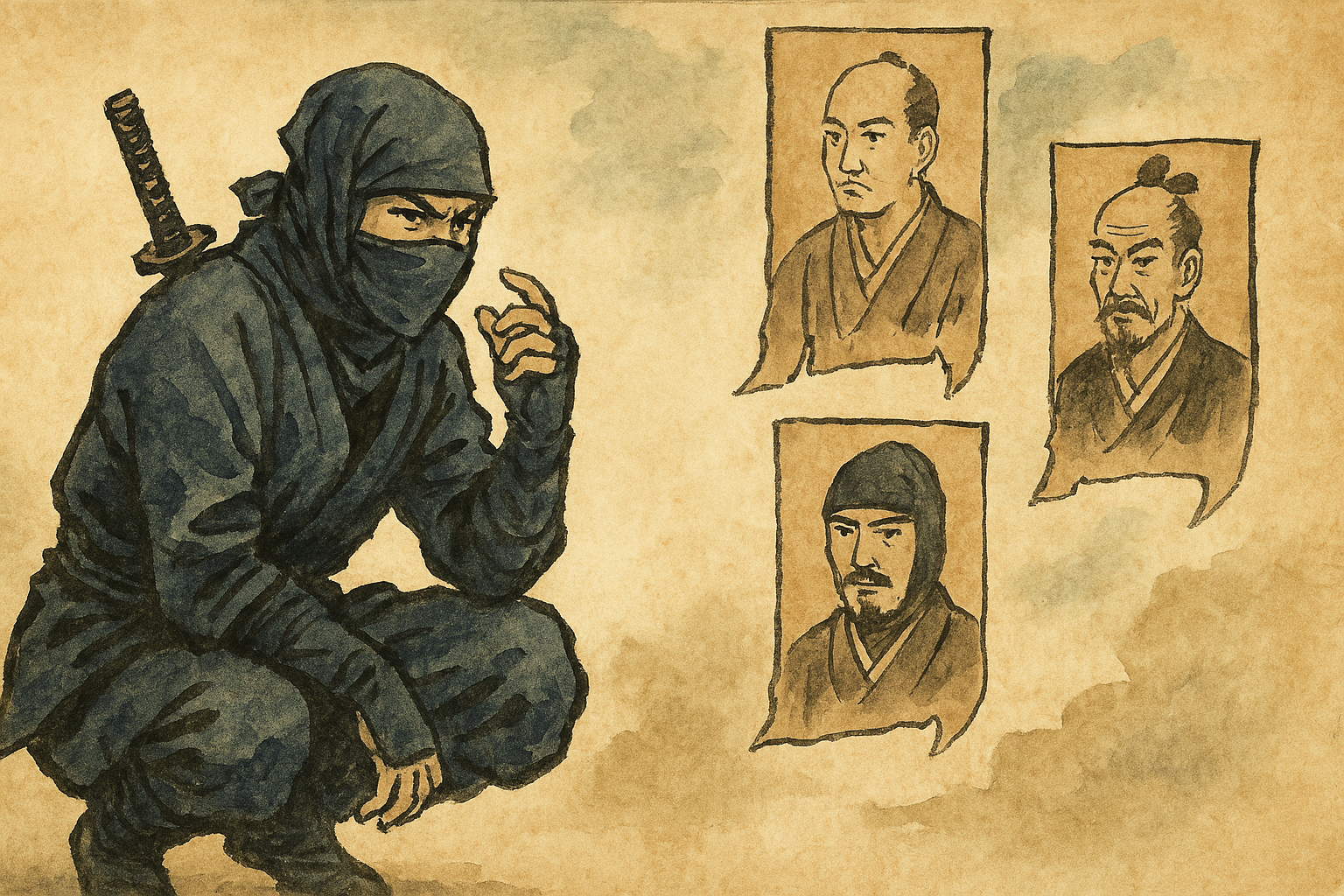本当にいた?歴史に残る実在の忍者たち
忍者――それは黒装束に身を包み、音もなく屋根を渡り、手裏剣を投げ、煙玉で姿をくらます者たち。
じゃが、こう思ったことはないか?
「忍者って本当にいたのか?」
答えは「YES」じゃ。
ただし、そなたが想像する“超人的な忍者”とは、少々違う存在かもしれぬのう。
今回は、「実在した忍者たち」の姿を通して、忍者という存在の真実に迫ってまいろうぞ!
忍者は本当に実在したのか?
忍者は架空の存在ではない。
確かに存在しておったのじゃ。
ただし、空を飛び、火を吹き、分身の術を使うような者ではない。
**実際の忍者は、情報収集、潜入、撹乱、破壊工作などを行う「戦国の特殊工作員」**だったのじゃ。
その存在は、文献や軍記、藩政資料などにも記録されておる。
中でも伊賀・甲賀・風魔といった地域は、忍びの里として特に知られておるのう。
実在の忍者1:服部半蔵(はっとり はんぞう)
最も有名な忍者名といえば、この服部半蔵であろう。
彼は伊賀の出身で、徳川家康に仕えたことで知られる。
「神君伊賀越え」と呼ばれる脱出劇において、家康を護衛し、伊賀の忍びを動員して三河まで導いた逸話が伝わっておる。
実際には、彼自身は槍の名手であり、武士としての顔が強かったが、伊賀衆の頭領として忍びを率いていたため、後世では「忍者の代名詞」となったのじゃ。
実在の忍者2:百地丹波(ももち たんば)
伊賀忍者の長として名高いのが、この**百地丹波(ももち たんば)**じゃ。
織田信長が伊賀を攻めた「天正伊賀の乱」において、伊賀衆をまとめ、激しい抵抗を指揮した人物とされておる。
後の服部半蔵とも関係があったとも伝わり、伊賀流忍術の根幹を築いたとも言われておるが、その詳細には不明な点も多く、いまだに謎多き人物でもある。
忍者という存在が“影の者”であるがゆえに、その姿もまた霧の如くあいまい。
それもまた、忍者らしき話であろうな。
実在の忍者3:風魔一族と「風魔小太郎」
北条家に仕えた風魔一族もまた、実在の忍者集団として知られておる。
相模国(現在の神奈川県)を拠点とし、夜襲や火攻め、攪乱工作などを得意とした、戦の影で動く忍び衆じゃった。
この風魔一族の首領は代々「風魔小太郎(ふうまこたろう)」の名を襲名しており、特定の一人ではなく、代々続く忍びの長の称号であったという。
忍者のリアルとは?
さて、ここまで実在の忍者たちをご紹介してきたが、
そなたが思い描いていた忍者像と少し違ったかもしれぬな。
・大勢を相手に手裏剣を投げまくる
・口から火を噴く
・瞬間移動のような術で消える
これらはあくまで娯楽作品の演出であり、実際の忍者は、
・必要最低限の道具を使い
・身を隠し、敵に悟られずに行動し
・戦いを避け、情報を持ち帰る
知恵と工夫、そして覚悟で動く者たちじゃったのじゃ。
まとめ:忍者は歴史の中に確かにいた!
・忍者は実在し、戦国の世を「影で支えた存在」だった
・服部半蔵、百地丹波、風魔一族など、実名で記録された者たちも存在する
・華やかな戦場の裏には、必ずと言っていいほど“忍びの働き”があった
忍者とは、歴史の中の真実と、文化としての魅力を併せ持つ存在。
今、我らが伝えておる忍者の姿もまた、そうした歴史の積み重ねの上にあるのじゃ。
現代の世においても、
「己の身を律し、気配を消し、任務を全うする」その精神は多くの学びを与えてくれる。
そなたも、かつての忍びたちの姿に想いを馳せ、
「現代に生きる忍びの道」を歩んでみるのも良きことかもしれぬのう!
忍びは、今もなお生きておる
【以下英語版】【English version below】
Real Ninjas in History: Were They Real? The True Stories of Historical Shinobi
When you hear the word “ninja,” what comes to mind? A shadowy figure in black, silently leaping across rooftops, hurling shuriken, and disappearing in a puff of smoke?
But have you ever wondered: “Were ninjas actually real?”
The answer is a solid “YES.”
However, real-life ninjas were not the over-the-top superhumans seen in anime or action movies.
Let’s explore the lives of real historical ninjas and uncover the truth behind these shadowy warriors.
Were Ninjas Real?
Yes—they truly existed.
But rather than flamboyant warriors, real ninjas were masters of espionage, sabotage, infiltration, and survival. Think of them as the intelligence agents or special forces of the Warring States period (Sengoku era).
Their activities and presence are recorded in historical documents, clan records, and regional archives. The most famous ninja regions include Iga, Kōga, and Sagami (home to the Fūma clan).
Real Ninja 1: Hattori Hanzō
One of the most famous names associated with ninjas is Hattori Hanzō.
Born in Iga Province, Hanzō served Tokugawa Ieyasu. He is best known for leading Ieyasu to safety during the infamous “Iga Escape” following the Honnōji Incident.
Although known as a ninja, Hanzō was actually a renowned spearman and samurai, who led and managed Iga ninja forces. His leadership and loyalty made him a legendary figure in Japanese history.
Real Ninja 2: Momochi Tanba
Momochi Tanba is remembered as a prominent leader of the Iga ninja.
He is said to have organized the resistance against Oda Nobunaga’s invasion of Iga in the Tenshō Iga War.
Some traditions also link him to Hattori Hanzō and the development of formal Iga-ryū (Iga school of ninjutsu), although exact details remain elusive. Like many ninjas, his life is cloaked in mystery.
Real Ninja 3: The Fūma Clan and “Fūma Kotarō”
The Fūma clan served the Hōjō family in the Sagami region (modern-day Kanagawa Prefecture).
This ninja group specialized in guerrilla tactics, night raids, fire attacks, and psychological warfare.
The leader of the Fūma clan was known as “Fūma Kotarō,” a title passed down through generations. The name refers not to a single individual, but to the collective identity of the clan’s successive leaders.
The Truth About Real Ninjas
As you can see, historical ninjas were not magical assassins but elite operatives. Unlike their fictional counterparts, real ninjas:
– Used minimal equipment
– Avoided detection
– Focused on gathering intelligence rather than open combat
Their strength lay in wisdom, adaptability, and discipline.
Conclusion: Ninjas Walked Among Us
Ninjas were very real and played critical roles behind the scenes during Japan’s turbulent history.
Figures like Hattori Hanzō, Momochi Tanba, and the Fūma clan leave little doubt that skilled shadow warriors existed.
Even today, the spirit of the ninja lives on—through martial arts, cultural practices, and modern stealth techniques.
So, the next time you hear the word “ninja,” remember:
They were not just legends—they were history’s silent shadows.



